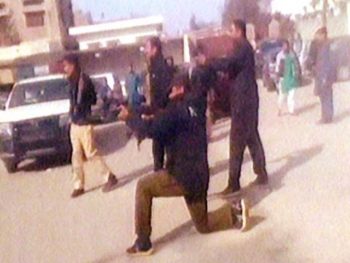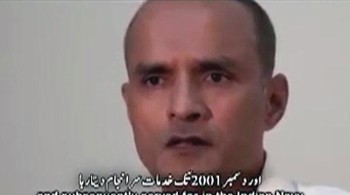
ISLAMABAD: The Human Rights Commission of Pakistan (HRCP) on Friday issued its annual report saying that four journalists were killed during one year while 1,100 women were murdered in the name of honour during this period.
The human rights indicators remained alarming in the country but the overall law and order situation significantly improved in 2015 as there were 31 percent less suicide attacks and 40 percent decrease in death of people as a result of violence. The anti-state violence dropped below 2008 levels, when incidents of terrorism had started escalating.
The statistics were made part of the ‘State of Human Rights in 2015’ launched by the Human Rights Commission of Pakistan (HRCP) on Friday. The report says though Balochistan witnessed the highest militant attacks in 2015 as compared to other parts of the country, there was an overall 41 percent decline in militant activities in Balochistan as compared to the year 2014. In Khyber Pakhtukhwa, the decline was 75 percent.
In terms of number, the report says that a total 706 militant attacks took place in 2015, in which 1,325 people were killed. There were 18 suicide attacks reported in Pakistan during 2015.
While presenting the report, HRCP Co-chairperson Kamran Arif said that the Punjab reported 382,932 cases of crime in 2015, 6,622 less than 389,554 cases in 2014. Sindh saw a 42 percent reduction in the number of murders in 2015 as compared to 2014. Khyber Pakhtunkhwa and Balochistan witnessed 10 and one percent surge respectively in total crime in 2015 as compared to 2014.
Jails, prisoners and missing persons
About jails, prisoners and disappearances, the report states that 65 prisoners died in the country’s prisons, 419 persons were awarded the death penalty, 327 death penalty convicts were hanged, making Pakistan one of the highest executing states in the world. Besides that, 1,390 cases of enforced disappearances remained pending with the commission of inquiry. The HRCP data suggested that least 151 cases of disappearances were reported in Balochistan between January and November 2015.
Free thought
In its section on freedom of thought, conscience and religion, the report shares that 58 incidents of sectarian violence were reported from across Pakistan, 22 individuals were booked on the charges of blasphemy including 15 Muslims, four Christians and three Ahmadis.
About the freedom of expression, the report mentions that four journalists and a media worker were killed and assaults were made on many more which made Pakistan live with the dubious status of being ‘a dangerous place for journalists.’ It says that Pemra’s new code of conduct allowed auditing of live content of television channels and restrictions on live broadcasts. The report says that introduction of Prevention of Electronic Crimes Bill, if passed, poses serious threats to freedom of expression in cyberspace.
Talking about the freedom of assembly, the report says that Sindh and Punjab accounted for 71 per cent of all protests in Pakistan.
‘Worst’ passport in the world
With regard to freedom of movement, the report says that 65,000 names were removed from the Exit Control List including of Baloch activists Farzana Majeed and Mama Qadeer. Pakistan’s passport ranked one of the worst in the world to travel with; sharing a place with Somalia as the third worst passport in terms of travel restrictions.
Local government and laws
It says that federal parliament made 20 laws in 2015 and the president promulgated 12 ordinances. The provincial legislatures adopted 120 laws. With 40 laws enacted, Khyber Pakhtunkhwa had the highest legislative output, followed by Sindh (32), Punjab (31) and Balochistan (17).
It states that 2015 saw 324 people, most with no links to terrorism, being put to death. Another 8,000 prisoners stayed on death row.
The report termed local government elections a positive development and says that the gap between the number of male and female voters increased roughly by 68,000 over the past two and half years whereas more than 11.5million eligible voters remained unregistered.
It says that women remained poorly represented in the federal and the provincial cabinets and minority communities in Balochsitan, Sindh and Punjab were deprived of the right to vote for their own candidates directly.
Women and violence
About women, the document reports that a range of legislative changes took place at the provincial level to strengthen rights of women. During 2015, as monitored by HRCP, 939 women became victims of sexual violence, 279 of domestic violence. 143 women were attacked with acid or were set on fire. 833 women were kidnapped. Despite the volume of cases, the rate of prosecution remained fairly low. 777 women committed or tried to commit suicide.
The HRCP database recorded 987 cases of honour crimes in 2015 with 1096 female victims and 88 male victims out of which at least 170 were minors. It says that lifting of moratorium on death penalty brought 47 women prisoners in line for executions, with most having no recourse to legal aid.
25 million children out of school
About children, it says that a total of 3,768 child abuse cases occurred during this year. On the other hand, Pakistan saw an 80 per cent reduction in polio cases to 54 from 306 cases last year. Several bills on child protection remained pending.
In education, with 25 million children out of school and literacy rate still hovering around 58 per cent Pakistan continued to face grave difficulties in education. Only 0.42 per cent of the GDP was spent on health and healthcare in Pakistan was administered mainly by the private sector, which accounted for 70 to 80 per cent of all outpatient visits. Around 19 per cent of the population and 30 per cent of the children under the age of five were malnourished. Life expectancy at birth was 59 years and infant mortality rate 95 per thousand.
There were only 1,142 hospitals, 5,499 dispensaries, 5,438 basic health units, 671 maternity and child health centers with only 175,223 doctors, 90,276 nurses and 118,041 hospital beds for a population of around 190 million. Pakistan was ranked sixth amongst 22 high disease burden countries of the world. Incidence of TB stood at 231/100,000 population and prevalence of about 300 cases per 100,000 people.
Adding to that, more than 20million people in Pakistan, around 10 per cent of the population, suffered from neurological problems and disorders. There were approximately 4,000 licensed pharmacies in Pakistan, but as many as 100,000 illegal merchants also sold medicines. Total population of persons with disability (PWDs) was 5.035 million.
The report also includes a section on environment and says that Pakistan remained as one of the top ten countries threatened by climate change.


















